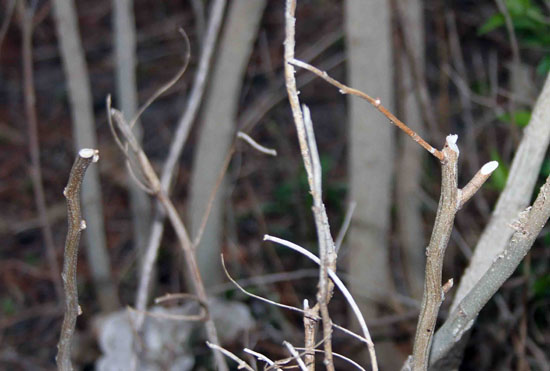Issue 1, April 28, 2014
Rabbits
The extended snow cover and cold weather during the winter has resulted in severe rabbit feeding damage to shrubs and small trees. Eastern cottontail is the primary rabbit species in Illinois. They are active through the winter primarily feeding on leafy vegetation from the previous summer. However, when snow accumulation restricts their access to these plants, they feed on the shoots and bark of small woody plants. The colder the temperatures, the more they eat to maintain their internal body temperature.
Damage on shrubs and young trees appears as bark stripped off of the stems and trunks. Cottontails will stand on their hind legs to feed, resulting in damage up to two and one-half feet above the ground. However, with their broad feet, they are able to stand on crusted snow and feed that high above the snow line. In drifted areas, we are seeing damage four or more feet high this spring. Stripped stems will usually die, but wait to be sure because even small strips of remaining bark will provide water and nutrients.
An interesting phenomenon we are seeing this year is no damage to the lower couple of feet on stems that were covered for months with snow. Axillary and adventitious buds on these undamaged areas will sprout twigs and foliage even though upper parts above girdled areas die. This will allow for quicker recovery of attacked shrubs as new shoots will not have to be produced off of the root system as happens when stems are girdled to the soil line.
The other type of rabbit damage being seen this year is clipped stems. They leave sharp, even cuts, similar to that made by hand pruners. The enlarged front teeth of cottontails are responsible for these clean cuts. Because they frequently fed while standing on crusted snow drifts, these cuts are commonly 3-4 feet above ground. Although the tips are gone, they will be replaced rapidly by breaking buds lower on the stems.

Rabbit damage to hackberry.

Rabbit damage to sumac.
Both high girdled and clipped stems will tend to result in bushy growth as many buds will break and grow new stems and leaves. Pruning will be needed later in the season to recover the desired appearance.
This damage could have been prevented with a late fall spray after it had gotten cold of rabbit and deer repellent containing thiram or other effective active ingredient. A second application in late January through February would have provided winter-long protection. Damage from whitetail deer will have ragged edges because browsers grab stems in their mouths and jerk them free. (Phil Nixon)
Author:
Phil Nixon